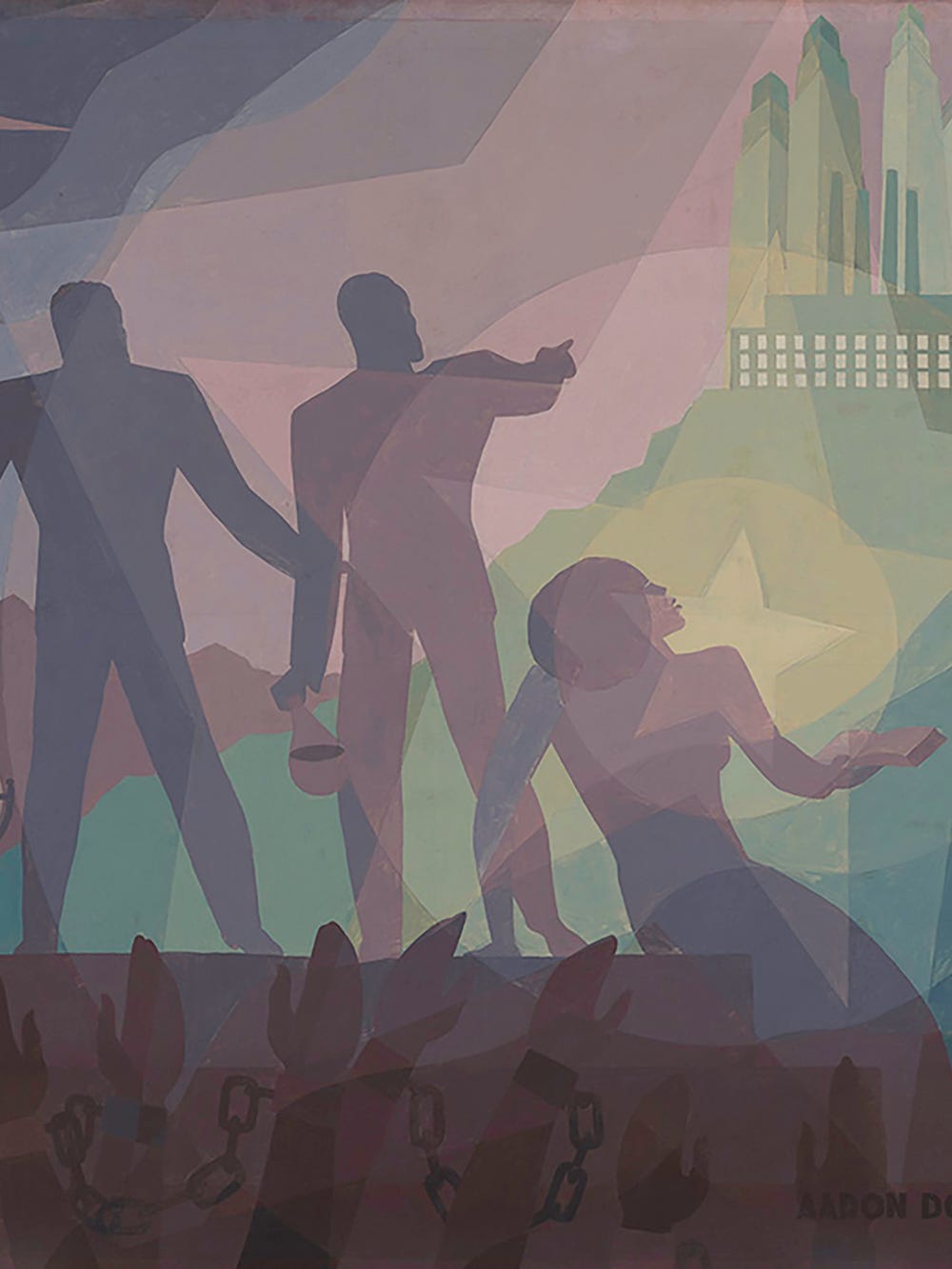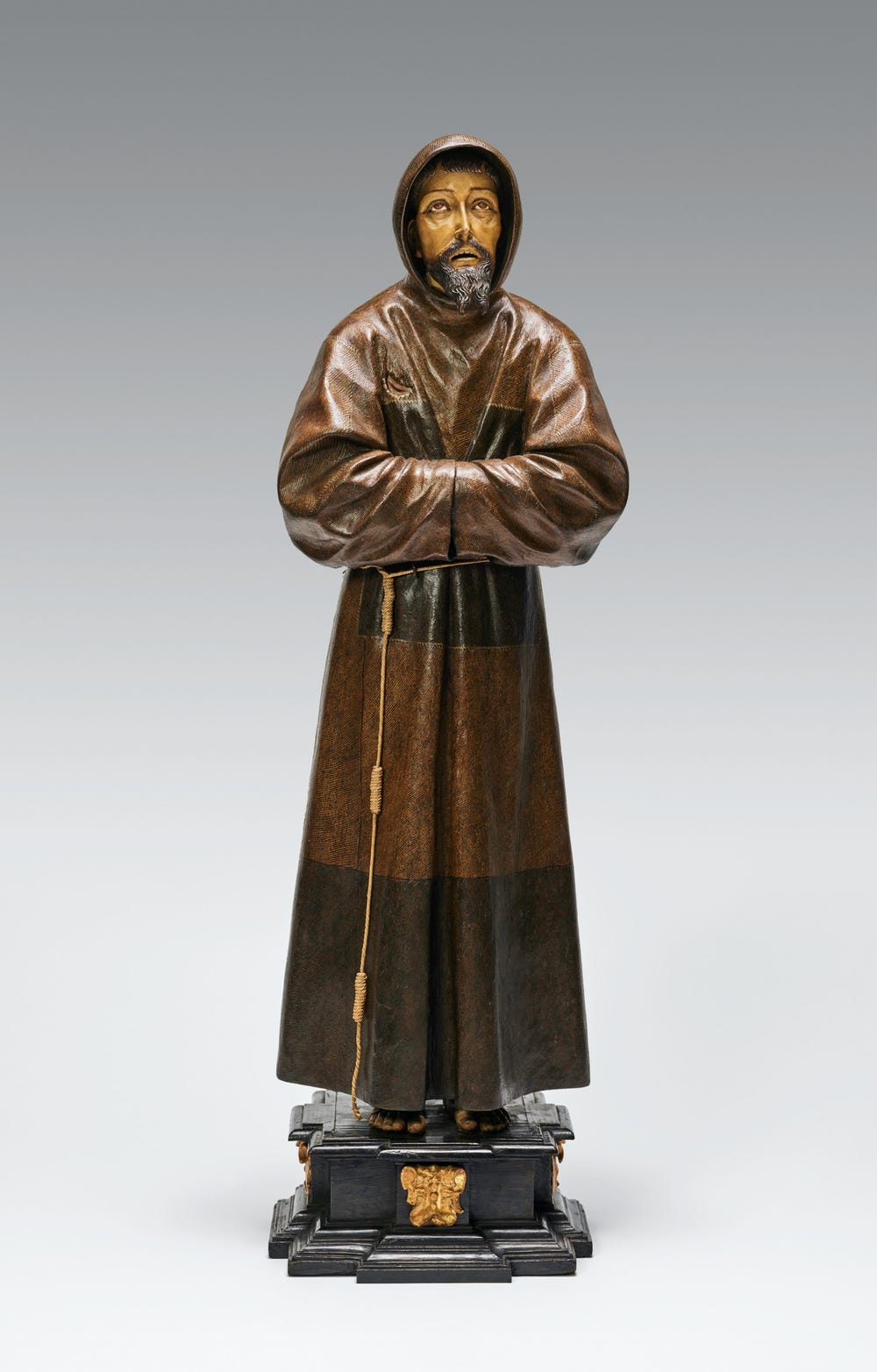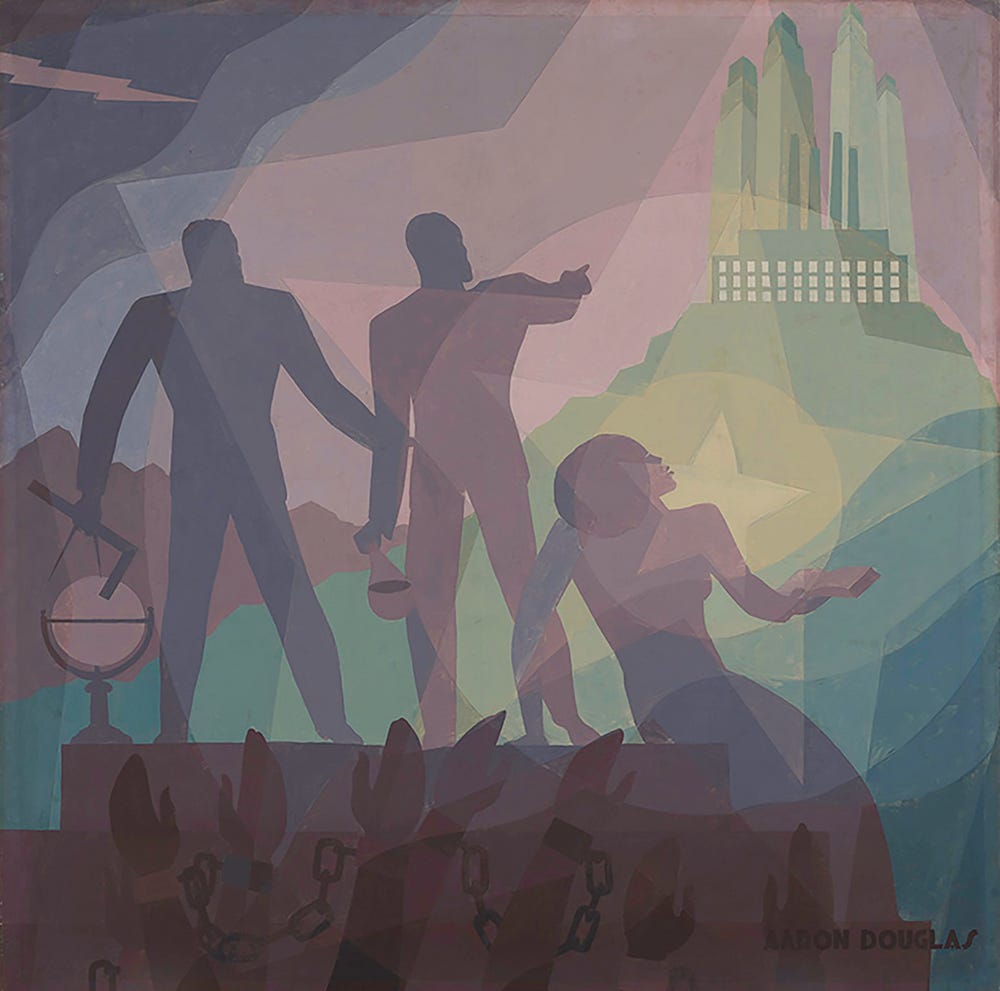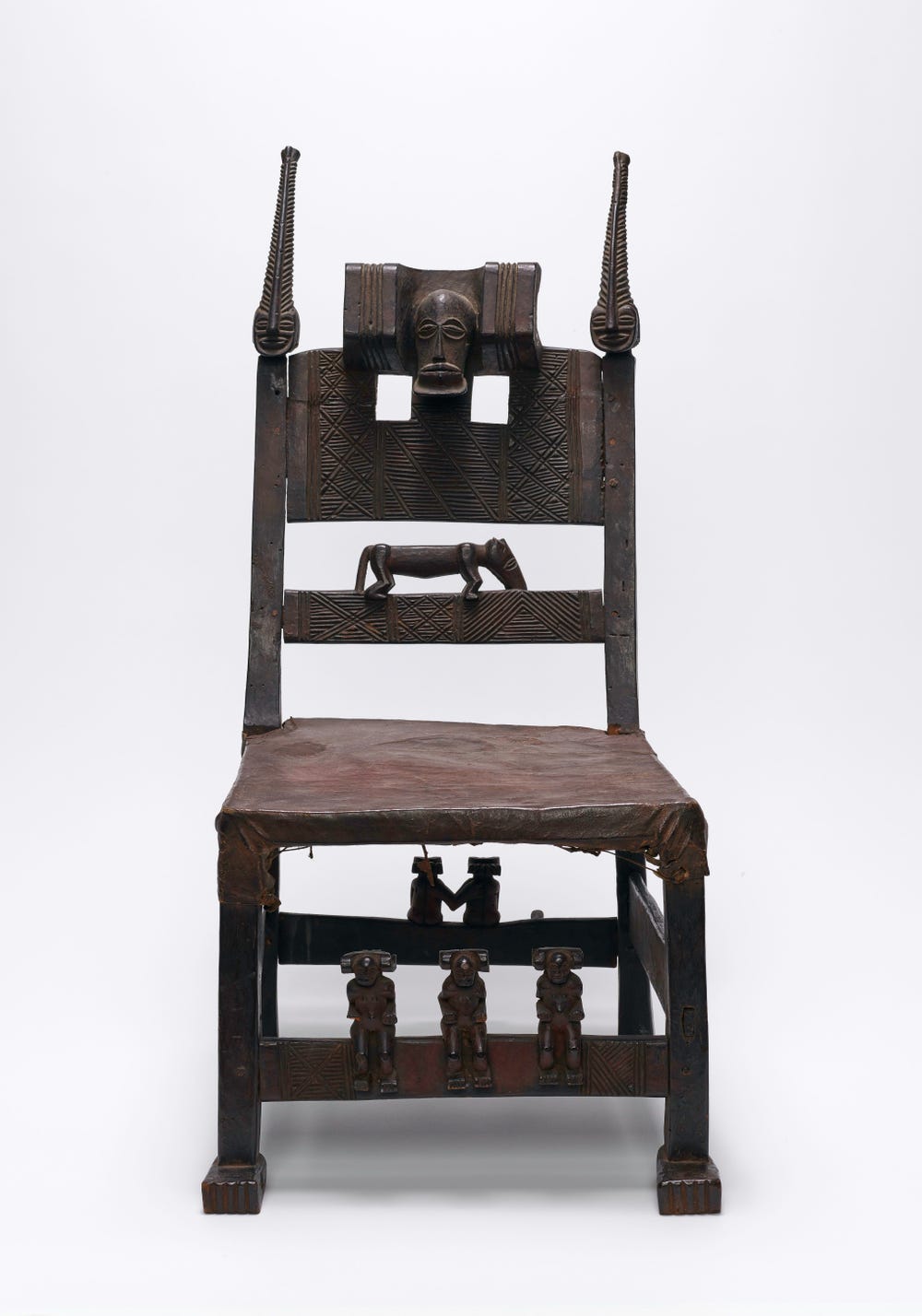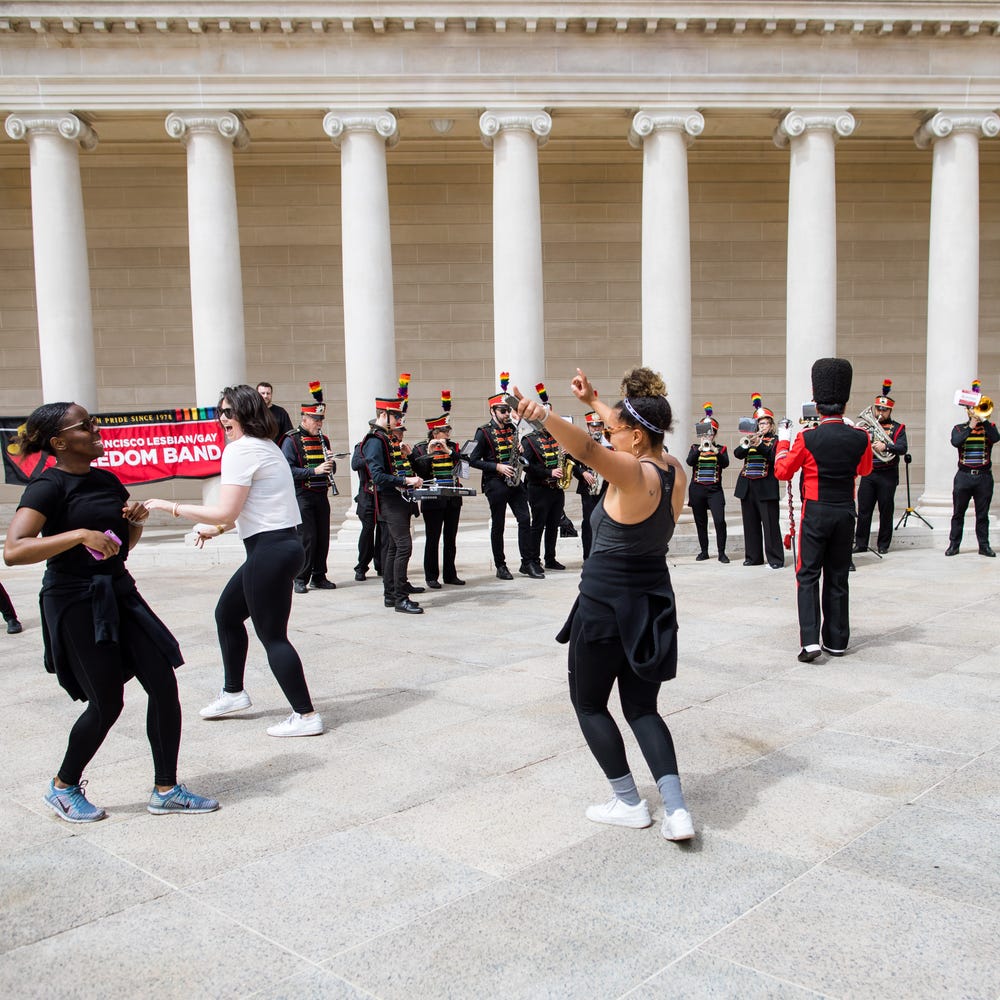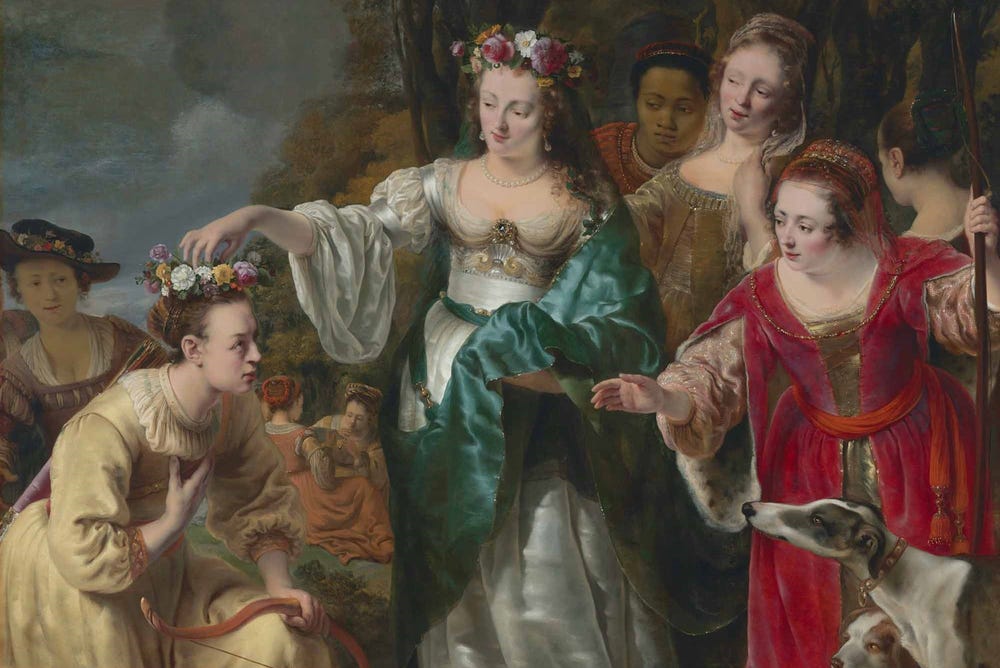Episode 5: Objects of Power
Leighanna: I have a question. What does power mean to you?
Kaitlin: For me, power means people coming together to fight for what's right and bringing about change for the better.
Elizabeth: To me, power is authority over someone or a group of people. It can be good or bad based on how it's used.
Leighanna: In the past and today there is a way to show how different communities, leaders, and individuals understand and represent power. Hi, I'm Leighanna.
Kaitlin: I'm Kaitlin. Elizabeth: I'm Elizabeth.
Leighanna: And we're the museum ambassadors at The Fine Arts Museums of San Francisco.
Kaitlin: As we talk more about three works of art in the museum's collection through the lens of wealth, privilege and power, think about how these ideas are relevant today.
Kaitlin: Well, look at that star in the center. It's so bright compared to the rest of the painting. Why are there people in chains on the bottom? Wait purple and yellow are complementary colors. I wonder why this artist chose to use them.
These thoughts were going through my mind when I first looked at this oil painting called Aspiration by Aaron Douglas. I was curious as to what Douglas was really trying to tell his audience and why these elements were painted. This piece is part of a mural cycle that he painted to represent the lives and journeys of African Americans. The importance of looking for hope and towards a better future can really be read through the title Aspiration and through the way the figures are shown in this piece.
Now take a second and put yourself in this painting. Imagine you are one of the standing figures pointing towards the star. Each figure holds something different. One holds a book, the other holds a compass and a ruler. And the last holds an Erlenmeyer flask, a piece of equipment used in chemistry. You have the tools to take action and speak up for yourself and those around you. The idea of agency and using one's voice is still prominent today as it was in the past.
Aaron Douglas played a very important role in the Harlem Renaissance. He found that other African-American artists needed to be proud of who they were and to embrace their background. Aspiration and the mural panels were painted for the Hall of Negro Life in the Texas Centennial Exposition in 1936. Douglas wanted to portray what life was like through the perspective of African Americans.
The work was also meant to advocate for equality for all and the ending of racial violence. Douglas himself experienced racism and discrimination while working at a Cadillac plant in Detroit. I gained a lot more respect for him and his work because it takes a lot of courage to speak up and inform others of injustice and equality. In fact, while these paintings were on display at the exposition, many people were shocked to learn that the artist who made these paintings was African American.
The main elements that I saw on this piece were the standing figures, the right star, the building and the rest was shackles. The star that the figures are pointing towards could represent the North Star and path to freedom. The raised shackled wrists on the bottom of the painting represent enslaved people and their struggle to gain freedom. Next, the image of the woman holding a book symbolizes knowledge. The figure was painted in purple to reference royalty and African American pride. The other two figures embody new ideas and beliefs during the Harlem Renaissance.
I imagine Douglas painted the mural with so much passion because he had put himself in this painting, his hopes and his struggles. To me, this piece also portrays the fight for agency and self-determination. Personally, I see this idea through the standing figures. They look as if they won't back down for what they fight for. I gained a whole new perspective on Aspiration after talking with organizer and student Leyla Ba. Leyla talked about how the idea of change and reformation can be found in this piece.
Leyla Ba: I think when talking about Black people in America and people of color in America and oppressed people in general, when they speak to that narrative of optimism, I feel like the thing that gets my fire going is the idea of rebuilding. And I think every inspirational Black person has talked about this idea of reconstruction and rebuilding. And that requires a deep understanding, which then sort of embodies the hope that I was referencing.
Kaitlin: She also talked about the female figure and how it relates to women in society today.
Leyla Ba: I feel this interpretation of the female figure sort of allows for us to have a new interpretation of this image in today's context, because we see a lot of women and women across all spectrums of society, right? Like we have trans women, Black women, Indigenous women really come to the forefront of today's movement, which has sort of been a really quiet aspect of our political history. A lot of people don't realize that Black women specifically have been at the forefront of revolutionary thought specifically not necessarily the mobilization of society. This idea that you have to really go to the bottom of the barrel of society in order to make sure that you pull everybody up.
Kaitlin: Her comment really stuck with me because fighting against misogyny and advancing women's rights is still something we struggle with today. Women have always, and still are important figures in working towards civil rights.
Next, Leighanna will be exploring the importance of the Chief’s Chair, an object that symbolizes authority within a community.
Leighanna: How does power affect the lives of communities both past and present? To what links are people willing to go to obtain status and privilege? Rulers come and go, but the chair remains as a symbol of authority. What does the chair mean to you?
This object, the Chief’s Chair is significant in the Chokwe community, expressing power in the community, the chief chair was made for the Mwanta. But it's not used for seating like most chairs. The chair was placed in front of the Mwanta to remind the people of the relationship between the people and the chief.
Elizabeth Cameron: I'm Elizabeth Cameron. I'm a professor in the history of art and visual culture at the University of California at Santa Cruz.
So it belonged to Mwanta. And he didn't actually sit in it. It was set in front of him or beside him in formal ceremonies, as a reminder to people who saw it, of how the chief would take care of them. Or Mwanta would take care of them and what their responsibility to the Mwanta was. So it goes both ways, both the Mwanta's responsibility and the people's responsibility.
Leighanna: It is carved out of wood and is engraved with figures and heads. Seeing the chair, I first noticed the large figure of the head wearing a headdress representing leadership.
Elizabeth Cameron: In the center back of the chair there is one figure, one face that has a very sort of square head dress. This particular design represents Chihongo, which is a masquerade figure or a Likishi that appears during boys' initiation ceremony.
Leighanna: Curious as to why the figures were placed on the chair, I learned that the figures were used in special initiation rights. The two antelope horns on the top of the chair symbolizes fertility of the land. The back of the chair represents the spirits of ancestors, which shows authority over local communities.
Elizabeth Cameron: The two figures on the right and left flanking Chihongo are Makhusa. They are representations of bush spirits, of ancestors brought to life, but representing the uncivilized. They do represent the fertility of the land.
Leighanna: The Chokwe community is located in Central Africa and covers a large number of countries. Politically, the Chokwe people are grouped into small communities. There's a paramount Mwanta who is above all other chiefs. The leader is chosen from a group of eligible candidates by a group of wise older people. The person in possession of the specific chair was a ruler of a small part of Angola. Among the Chokwe people, what somebody sits on reflects their status in the community.
Elisabeth Cameron: Somebody of low status in a community might sit on the ground or on a scan or a mat. And it's only when somebody gained status in the community that they are given chairs to sit on.
Leighanna: The chair reminds me of how crowns are significant in European monarchies. Power in the Chokwe community is inherited from the maternal uncle. The religious belief in the Chokwe community centers around a relationship of respect, worship, and living with the ancestors. The Mwanta is said to be the representatives or go between the ancestors who are able to control health and fertility of the land. Works of art like carved objects are said to be spiritual. For example, the chief’s chair connects the chief to the ancestors, making it a symbol of power. Because of this, the chair reflects the power of the ancestors and also the people. It is a reminder of Mwanta's responsibility for the people.
Elisabeth Cameron: As a visual reminder to them of what the Mwwanta could give them, how the Mwanta could support them. So their approach to it would be one of respect, but not necessarily fear.
Leighanna: Other objects such as baskets and masks are also spiritual and can connect people to their ancestors. Their belief enables them to view the chair as a sacred spiritual object. What object represents power in your community?
Elizabeth: In the Christian tradition, Saint Francis of Assisi was a saint and was known for trading his life of luxury for a life of modesty to become closer to God. This sculpture made by Bernardo del Rincon depicts Saint Francis based on a description of a visit to the saint's tomb over 200 years after his passing.
With his body upright, eyes opened heaven word, hands concealed, and Stigmata bleeding as though freshly inflicted. Bernardo del Rincon used painted wood rope in glass to create a representation of the same. The knots represent the core values he and his followers believed in: poverty, chastity and obedience. His glass eyes are looking upwards and his mouth is slightly opened as if in shock or amazement. To add to his plainness, he has a simple robe on with different patches of brown. His hands are clasped together and he is barefoot. This suggests the simplicity and humbleness of his life. Saint Francis was also the first saint to receive stigmata, the wounds on his hands and feet similar to Jesus Christ when crucified. According to Thomas Wu, curatorial assistant for European Decorative Arts and Sculpture at the Fine Arts Museums, the sculpture depicts a bloody wound or stigma on Saint Francis's right chest, which Wu believe signifies his suffering and endurance.
Thomas Wu: It's not a very glaring detail. The wound is not fully revealed. It isn't gushing blood. There isn't blood seeping into the fabric of his robe. And yet I think that discretion has quite a bit of power, that he wasn't one to display his suffering overtly; rather he bore it quietly with genuine endurance.
Elizabeth: Saint Francis's hardships can be understood through careful looking of the sculpture and can be made more clear when learning his story.
When I initially saw the sculpture of Saint Francis, I thought he was someone who lived his life of modesty out of necessity, but it was quite the opposite. I believe that Saint Francis, who was known for partying and drinking as a youth was lost in life before finding God. Like his father, Saint Francis was supposed to be a merchant. Uninterested in cloth trade, he wished to be a knight. At the first chance he joined the war during which he was imprisoned. After being in jail, he received a vision from God, which he took literally. He would fix the Christian church and live his life in poverty, giving him his purpose.
Saint Francis, after leaving his father in life of luxury, put on a used robe and never looked back. In doing so, he developed a deep love for nature and became the patron saint of animals. I was surprised by how easily he gave up his worldly possessions. I think this was so easy for him because he finally knew what he had to do with his life. Thomas Wu believes that. During the coronavirus pandemic, many people can relate to what Saint Francis went through.
Thomas Wu: I think many of the virtues that he embodied and inspired in his followers through the centuries: sacrifice, optimism, endurance are qualities that people have had to really rely upon during the coronavirus pandemic. We've all had to make sacrifices, whether that be staying home in order to protect others, social distancing, or those who are on the front lines, doctors, nurses.
Elizabeth: Though he was materially powerless, he had many followers who believed in his teachings and lived in poverty as well. He also died a saint, which is considered high status for those of the Christian faith. His values are still followed today, which emphasizes being selfless and modest. Wu talks about how, even though Saint Francis most likely did not want authority, through his sacrifice to God in humility, he gained a lot of it. Power isn't necessarily only for those who are rich, but can be gained when living an honest life like that of Saint Francis.
Kaitlin: The three objects we look at represent different kinds of power and how it influences the lives of people in their communities.
Leighanna: Yeah! Today we can see people fighting back for rights and equality. Protestors all over the world are creating art like murals and photographs as a tool to fight against injustice.
Elizabeth: How can you use your power and engage in issues you believe in through your voice and creativity.
